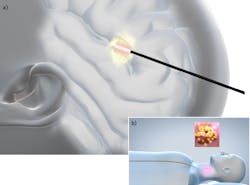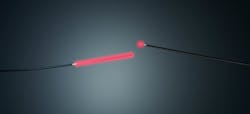Advanced laser light delivery improves medical treatments
Over the past few decades, lasers have become an important tool for treating a variety of medical conditions. For example, laser-induced thermal therapy (LITT) uses optical fibers to deliver laser light directly into tissue to eliminate tumor cells or lesions that cause epilepsy, while photodynamic therapy (PDT) and photoimmunotherapy (PIT) both rely on photosensitizers and light to target cancer (see Fig. 1). Homogeneous and efficient laser light delivery via an optical fiber with a diffusing end-tip is the prerequisite for their success.
Recently, LITT, also referred to as laser-thermo ablation, has provided stereotactic neurosurgery with a new option for minimally invasive treatment of brain tissue. In a real-time MRI procedure, LITT relies on a laser catheter inserted into the skull through a tiny hole to deliver laser light, typically at 980 nm or 1064 nm wavelengths. This generates the heat needed to selectively ablate a lesion or kill cancerous cells. The first LITT system on the market was FDA-approved in the U.S. in 2007 and just recently received CE approval in Europe in 2018.1,2 LITT is a promising treatment method for hard-to-access brain tumors and for drug-resistant epilepsy.
PDT is a noninvasive treatment method that selectively destroys cancerous tissue after light activation typically with red light wavelengths (e.g., 665 or 690 nm). A light-sensitive drug called a photosensitizer accumulates in malignant cells. When activated by laser light, the drug creates a toxic form of oxygen that destroys the cancerous cells with only minimal damage to adjacent healthy tissue. Cancers associated with the skin, bladder, head, or neck can be treated with PDT.
Similar to PDT, PIT is based on light delivery in the red spectrum (e.g., 690 nm). It uses a light-activated antibody-dye conjugate to destroy cancer cells and stimulate the immune system. PIT was first approved in Japan for the treatment of certain head and neck cancers in 2020.3
Controlled light delivery is equally important for procedures such as endovenous laser therapy, which is used to reduce varicose veins. It is also used for dermatology applications including lesion removal, hair reduction, and psoriasis treatment, as well as for procedures that help reduce the infection of mucous membranes. In antimicrobial dental applications, lasers are used to destroy the bacteria that cause gum disease.
High performance meets custom design
Cylindrical diffusers show promise for a variety of medical therapies. Manufactured from proprietary optical glass, they are based on a customizable glass matrix that incorporates unique scattering elements, enabling excellent homogeneous light radiation with a variance that is typically less than ±10% across the complete diffuser length. For LITT, this means surgeons can heat tissue in a controlled fashion, virtually reducing unwanted hot spots. For PDT and PIT, homogeneous light radiation enables surgeons to apply an identical light dose along the full length of the diffuser.
The glass matrix can be customized to accommodate a large variety of wavelengths, spanning from the near-UV to near-IR ranges of the spectrum. Customization can also be applied to create diffusers with body lengths that range from approximately 3 mm to 50 mm. If a product design has requirements outside this range, other dimensions are available upon request. Radiation profile testing has shown a high repeatability across the diffusers of a series.
Furthermore, these diffusers exhibit very high efficiency levels, with typical levels of 80% to 90%. This means the laser light is emitted efficiently with less light absorbed by the diffuser’s body. The higher the efficiency, the lower the back reflection. This makes the laser more stable and thus less prone to shutting off or breaking due to overheating—a critical factor for LITT applications. For PDT/PIT applications, a diffuser that absorbs less heat stays cooler, which results in higher performance.
Looking at the distal end of the cylindrical diffuser, another important feature is the multilayer reflector, which allows for a very low residual radiation of typically <0.5%. This leads to improved homogeneity and efficiency as well as to a controlled beam direction, allowing surgeons to work with a controlled and targeted side-emission area. It also avoids direct frontal emission as well as unwanted hot spots. An optional beam blocker at the distal end can eliminate any transmitted radiation (see Fig. 3).The high wattages (up to 15 or 20 W) needed in LITT applications are no problem for cylindrical diffusers, and research is underway to increase these powers even more. The goal is to offer larger power scales for more flexibility than has been possible with other materials such as polymer optical fibers.
A variety of diffuser shapes
In addition to cylindrical shapes, SCHOTT (Mainz, Germany) offers a complete diffuser series with spherical, front-emitting, and special-shaped diffusers. The front-emitting diffusers radiate light only from the tip. This shape ensures that the directional output from the fiber is broadened in a very precise manner, leading to an even intensity over the whole area. These diffusers are used to perform PDT on tumors close to the skin as well as for various dermatology treatments. The diameter of front-emitting diffusers can be adjusted to match that of the delivery fiber, with a typical core diameter of 400 µm and an outer diameter ranging from 600 µm to 1000 µm, depending on the buffer.
Also available are spherical diffusers featuring ball-shaped components added to the tip of a fiber to create a 360-degree radiation pattern that can be radially homogeneous or manipulated for a more forward- or side-emitting radiation effect (see Fig. 4). A spherical diffuser evenly applies light inside hollow areas such as the inside of the bladder. Typical diameters for this geometry are between 0.3 and 1.0 mm.Diffusers can also be designed for custom light output. For example, emission for the cylindrical or spherical diffusers can be limited to a certain angle to deliver diffuse light to a spatially constricted area. Optical components can also be added to a cylindrical or front-emitting diffuser to create a certain light homogeneity or to create diffused light output with a specific shape. Biocompatible surface treatments and coatings can also be applied to the diffusers to fulfill medical requirements included in standards such as DIN ISO 10993 or USP Class VI.
A partner in light delivery
Although diffusers may seem like a simple component, achieving extremely homogeneous radiation characteristics with high powers and high efficiency is challenging. Development of the proprietary glass-based material was a result of SCHOTT’s more than 130 years of experience in glass processing and in transporting light through glass, as well as a long track-record in the medical device industry. Manufacturing the diffusers requires advanced glass bonding as well as coating capabilities, both available in-house.
The company’s experts can help with early-stage development, device design and prototyping, application engineering, and customization. When it comes to production, SCHOTT can provide high-volume serial production that meets all commercial demands, an ISO class 7/8 cleanroom, and medical production facilities with ISO 13485 certification that are registered with regulatory authorities.
REFERENCES
1. See https://bit.ly/MedtronicRef.
2. See https://bit.ly/NeuronNewsIntlRef.
3. See https://bit.ly/JapanTimesJul21.
About the Author
Anthony Cappabianca
Business Development Medical Principal, SCHOTT North America
Anthony Cappabianca is the Business Development Medical Principal at SCHOTT North America (Southbridge, MA).
Haike Frank
Marketing Director, SCHOTT AG Lighting and Imaging
Haike Frank, Ph.D., is the Marketing Director at SCHOTT AG Lighting and Imaging (Mainz, Germany).
Bernd Schultheis
Manager of Application Engineering Medical, SCHOTT AG Lighting and Imaging
Bernd Schulthe is the Manager of Application Engineering Medical at SCHOTT AG Lighting and Imaging (Mainz, Germany).



